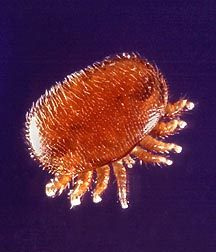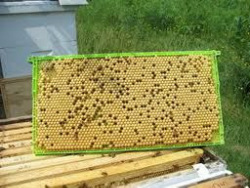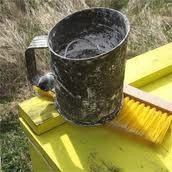
I believe that mites are the single worst enemy of a hive. Mites slowly suck the bees’ hemolymph, their blood, weakening the entire hive, stressing it and rendering it vulnerable to disease. To suck their blood, mites cut an opening in the bees’ protective exoskeletons, creating wounds that allow bacteria and viri enter. The mites themselves are vectors of disease, incubathing and injecting bee diseases. Get rid of mites and your hive will be healthier and happier. I try to avoid chemical treatments. The following is a description of some natural methods I use to control mites.
Monitor a mite infestation: First, check to see if you have mites. You can do this if you open some capped drone brood during a hive inspection. Mites prefer to breed in capped drone brood (not worker brood), so as you work in the hive, if you open some drone brood, carefully inspect those fat, white drone bodies for mites. Look for tiny red spots on the pearly white bodies. If you find a single mite, you probably have a mite infestation.

Have ready two green plastic drone frames per infested hive. Green drone comb is like a drone magnet: The comb template is larger than worker bee template, encouraging the queen to lay drone eggs. Place one frame of green comb in the center of the brood area of the top hive body and let the bees have a go at it. During high drone season, spring and early summer, the bees will draw out the foundation quickly and the queen will start laying drone eggs soon. About three weeks after you have placed the first green comb in the brood box, go back and examine it. Check that most of the drone brood has been capped. If there are still more than 50% uncapped drone larvae, wait a few more days to pull it.
Once more than 50% of the drones are cappted, remove the green comb and place it in the freezer . Replace it with the second green frame. This starts the drone reproduction cycle again. Wait another three weeks more weeks have passed to pull and freeze the green comb again. At the same time, defrost the first comb and replace it in the hive. The bees will clean out the dead drone pupae and the queen will use the cells to lay another round of drones. After three more weeks, pull and freeze them again.
After two or three rounds of drone comb, replace the green frame with a normal wooden frame. Research shows that if you use drone comb to catch and freeze mites twice, you will be knocking back the mite population to about 90% as effective as a chemical treatment. If you do it a third time, even better.
The theory: The idea is to lure the mites into the drone comb. The mites vastly prefer drone comb because the drones are capped longer and they can breed longer. They wait until almost the last minute before scuttling into the drone cell just before capping. They know when to make a run for it because the drone emits a pheromone just prior to capping. Once inside the capped cell, it’s party time: the mites are free to feed off the drone and food in the cell while they reproduce. The most important thing is not to overlook pulling the drone comb out of the hive before the drones hatch. If you leave the drone comb too long and the drones hatch, you are actually encouraging mites to breed. Don’t miss the three week pull date!
The zen of the hive: I hate freezing those innocent drones. It helps to remember that bees want what is best for the hive. I truly believe that those drones would glady lay down their lives if they knew that through their sacrifice, they were improving the health and survival of the overall hive.
Scheduling: Start using the green comb early (like now). It works best during high drone production season, spring and early summer. After June, when drone production has settled down, the green comb method becomes less effective.

Powdered sugar theory: Mites transport from hive to hive from one bee to another. The idea is to sprinkle powdered sugar on the bees. The bees hate it, and they immediately start intensive grooming. While they are grooming, they knock off mites. The mites fall to the bottom of the hive. If you have a screened bottom board, they leave the hive through the ground floor (pun intended).
Throughout the summer, I powder my bees every time I open the hive. Some beekeepers prefer to place a screen over the brood box and brush powdered sugar into the hive through the screen once a month. I don’t do it that way. Instead, I have my sugar sifter filled with powdered sugar handy whenever I open a hive, and just sprinkle it over the bees that happen to be on top of the hive just before closing. I figure eventually I hit all the bees that way.


 RSS Feed
RSS Feed